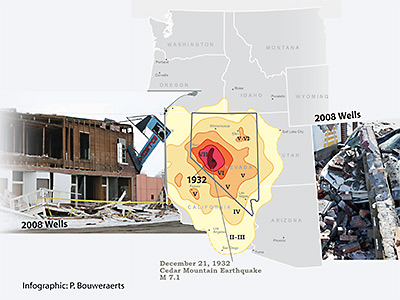
Photos of 2008 Wells, NV earthquake (Special Publication 27) and inset 1932 map (Special Publication 37) by Craig dePolo; with permission of Nevada Bureau of Mines and Geology. Click to enlarge.
Nevada has a high risk of earthquakes, and that includes large and violent quakes.
There were six seismic events of more than 6.0–6.4 magnitude in the 1800s.
“We’ve had five earthquakes since 1930 that were between 6.0–7.4 magnitude,” said Ben Davis, Environmental Health and Safety Program Manager, Truckee Meadows Community College.
A magnitude 4.7 quake radiated outward from the Mogul area in northwest Reno at 11:40 p.m. in late April 2008. Nevada is rated as having the third greatest risk of U.S. states for damaging seismic events. Davis added that there are more than 1,500 potential earthquake faults in the state.
In order to be better prepared for quakes, more than 540,000 in Nevada will take part in the Great Nevada ShakeOut drill on Oct. 20. In western Nevada, about 135,000 will participate.
- What: Great Nevada ShakeOut
- When: Thursday, Oct. 20, 10:20 a.m.
Worldwide, Great ShakeOut earthquake drills on Oct. 20 will be completed by 22.7 million people from seven countries and 46 U.S. states.
“I recommend this drill to faculty and students,” Davis said. “Students may have recently moved to Nevada and might not be aware of what to do when an earthquake happens. A quake, maybe a big one, can occur at any time.”
At 10:20, the TMCC community will practice what to do in the event of a major temblor. An emergency text message will be sent with the e2Campus system, and phone and email alerts will go out to the campus. Participating classes will enact the procedures of “Drop, Cover and Hold On”.
“It’s really important that we have this drill, because it helps the campus understand the real risk and be prepared for unexpected earthquakes,” he said. “It’s better to be prepared so you can survive the event and recover better afterwards. Participation in completely voluntary, but it’s just 60 seconds out of your day, and you can make a difference when seconds matter.”
The Great Nevada ShakeOut is a cooperative effort of:
- Nevada Department of Public Safety: Division of Emergency Management – Homeland Security
- University of Nevada, Reno (UNR)
- Nevada Bureau of Mines and Geology
- The Nevada Seismological Laboratory
A one-and-a-half minute video about being prepared for seismic events is available for viewing.
Drop, Cover and Hold On
Most injuries happen during a quake when heavy objects strike peoples' heads, Davis said. Windows, lamps and mirrors also shatter and shards can be strewn across escape paths.
Dropping is important because during the strong jolting, it is physically hard to walk—getting closer to the ground level will prevent falling, especially if glass is breaking. A crawling position may protect vital organs as well.
Because most injuries are to the head, covering the head and neck with a sturdy piece of furniture or the arms and hands will help protect this vital region.
“The best thing to hold on to is something that is less likely to slide across the room and the worst thing to hold is something you’re storing stuff on, such as a book case or china cabinet,” he said. “If there’s nothing, cover your head and neck, the sensitive areas.”
Experts advise to be prepared to move with the desk or table you’re holding on to until the shaking stops.
“Sometimes there is an aftershock within about a minute, so stay put for a couple of minutes before moving,” Davis said. “Later you can move or exit the building to an open area if needed. You want to immediately get out of a building that is crumbling around you, though, or if you smell gas.”
After a quake, assist any injured people and help to prevent further injuries. It is better to have a plan for connecting with family and friends, whether it is a quick text to let family know you are safe, or meeting up somewhere. Phone calls can clog emergency communication lines.
Urban Legend: the Triangle of Life
A theory known as the “Triangle of Life” has been circulated in social media. The thought is that if a person huddles down close to an object, such as beside a bed or a car, that structural elements will fall on that object and angle down to the ground, creating a safe triangle of space.
Scientists say that this is an urban legend, and untrue. Most injuries are not caused by structural collapse, but by objects and non-structural elements.
How Likely is a Quake?
For the 2015 ShakeOut drill, TMCC College News spoke with Annie Kell, PhD, Education and Outreach Seismologist, Nevada Seismological Laboratory at UNR.
“So this means that Reno, just like the Bay Area has a two percent chance of a large event (exceeding 80 percent the force of gravity or 0.8 g's) every 50 years,” Kell wrote in a follow-up email.
For more information about the Great Nevada ShakeOut, email Ben Davis or contact the Environmental Health and Safety (EHS) Office at 775-674-7951. The Nevada Bureau of Mines and Geology's booklet "Living with Earthquakes in Nevada," can be downloaded or ordered as a print edition.






